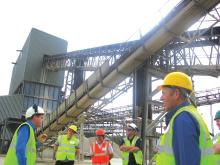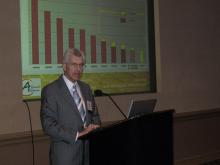
From December this year the new Machinery Directive will come into effect in Europe but what will it mean for the quarrying industry? Claire Symes reports
Improving health and safety is a top priority for the quarrying industry and safe equipment design has an important role to play in this area. New legislation can help drive improvements and, from December this year, the updated version of the Machinery Directive will come into force.
But what exactly will the latest directive mean for the design of new quarrying equipment and will it help to improve safety statistics in the sector? The answer from experts in the field of health and safety seems to be possibly.
According to the EU, the Machinery Directive 2006/42/EC provides the regulatory basis for the harmonisation of the essential health and safety requirements for machinery at
The EU claims that the directive promotes harmonisation through a combination of mandatory health and safety requirements and voluntary harmonised standards.
The new regulations will only apply to equipment placed into the EU market for the first time so will not impact on used equipment sales. The new directive was formally adopted on 9 June 2006 and is currently being transposed into national law ahead of the application date of 29 December 2009.
Some of the key changes from the previous 1998 directive include more explicit requirements relating to the use of risk assessments and more precise requirements concerning noise and vibration emissions.
Most agree that the new directive will set minimum standards but because it is very generalistic, quarry operators need to be proactive in asking dealers for better safety specifications.
Chairman of the
According to one safety specialist, one of the problems with introducing mandatory safety specifications is the concept of dealer fitment of such systems. "It is a well known fact that the dealers make much of their profit on new machines by fitting optional extras," he said. "By making such systems mandatory, they will be factory fitted giving dealers less room for manoeuvre on price.
"There is no easy solution to this but one of current problems facing equipment buyers is that the list of options and standard features vary from manufacturer to manufacturer as well as dealer to dealer. This makes it hard to compare machines effectively.
"Having a CE mark means that the machine complies with the regulations, but in practice how many quarry operators accept the machine as is in the manufacturer's basic specification?" According to Isles, the industry needs to be more proactive and build on the requirements of the directive and establish a list of basic safety features and a list of "nice to have" options.
Isles is also director of health and safety with the UK's Quarry Products Association and is leading a project that has just secured £55,000 (€61,000) of funding for a new safety project. Under the Safer by Design banner, Isles' team are aiming to develop a code of best practice for purchasers and users of mobile plant in minerals operations.
"With the project we plan to develop best practice for different types of machine based on both size and application, rather than following the current one size fits all approach." In essence, the new directive will not mean sweeping changes for machines on site but sets in place a building block on which improved safety standards can be built.









